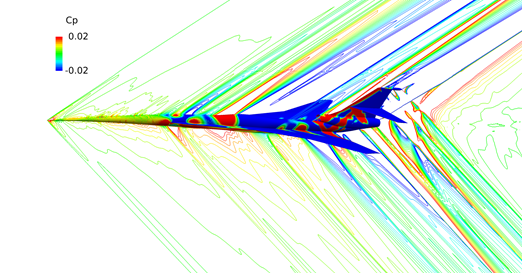Research and development for system integration of silent supersonic airplane technologies
JAXA Supercomputer System Annual Report April 2016-March 2017
Report Number: R16E0007
- Responsible Representative: Yoshikazu Makino(Next Generation Aeronautical Innovation Hub Center, Aeronautical Technology Directorate)
- Contact Information: Yoshikazu Makino(makino@chofu.jaxa.jp)
- Members: Junichi Akatsuka, Naoko Tokugawa, Hiroaki Ishikawa, Yoshine Ueda, Yuriko Kakei, Takuya Makimoto, Yoshikazu Makino, Dongyoun Kwak, Keisuke Ohira, Atsushi Ueno, Satoshi Kondo, Tatsunori Yuhara
- Subject Category: Aviation(Aircraft)
Abstract
The system integration design technologies for achieving low sonic-boom, low aerodynamic drag, low landing and take-off noise, and light weight simultaneously are the key technologies for future supersonic airplanes. JAXA is promoting the R&D for these technologies based on our experiences of demonstrating the advanced low-drag and low-boom design concepts.
Goal
Please refer ‘D-SEND project / Silent supersonic transport technology | Sky Frontier – Sky Frontier Program | Aeronautical Technology Directorate‘.
Objective
Please refer ‘D-SEND project / Silent supersonic transport technology | Sky Frontier – Sky Frontier Program | Aeronautical Technology Directorate‘.
References and Links
Please refer ‘D-SEND project / Silent supersonic transport technology | Sky Frontier – Sky Frontier Program | Aeronautical Technology Directorate‘.
Use of the Supercomputer
In the R&D for system integration of silent supersonic airplane technologies, the airplane design study of a small-size civil supersonic transport is conducted. Simulations for evaluating the aerodynamic performance and noise characteristics are conducted using JAXA supercomputer system.
Necessity of the Supercomputer
To achieve low sonic-boom, low aerodynamic drag, low landing and take-off noise, and light weight simultaneously, the multi-objective optimization tools are utilized in the design study. The super computer is necessary to obtain the multiple objective function efficiently with many numerical simulations.
Achievements of the Year
A numerical simulation of the sonic boom prediction of some configuration as a part of 2nd AIAA Sonic Boom Prediction Workshop is conducted in order to improve the numerical accuracy. CFD analysis of the 3 models using JAXA’s TAS solver were performed and their results were almost same as the other participant’s results.
Publications
Presentations
1) Ishikawa,H., Ueda,Y., and Tokugawa,N., ‘Natural Laminar Flow Wing Design for a Low-Boom supersonic Aircraft,’ 55th AIAA Aerospace Sciences Meeting, AIAA SciTech Forum, Grapevine, Texas, AIAA 2017-1860, 2017
Computational Information
- Parallelization Methods: Hybrid Parallelization
- Process Parallelization Methods: MPI
- Thread Parallelization Methods: Automatic Parallelization
- Number of Processes: 16
- Number of Threads per Process: 32
- Number of Nodes Used: 16
- Elapsed Time per Case (Hours): 1
- Number of Cases: 350
Resources Used
Total Amount of Virtual Cost(Yen): 16,940,064
Breakdown List by Resources
| System Name | Amount of Core Time(core x hours) | Virtual Cost(Yen) |
|---|---|---|
| SORA-MA | 9,139,249.56 | 14,883,886 |
| SORA-PP | 215,468.95 | 1,839,673 |
| SORA-LM | 2,198.74 | 49,471 |
| SORA-TPP | 0.00 | 0 |
| File System Name | Storage assigned(GiB) | Virtual Cost(Yen) |
|---|---|---|
| /home | 364.81 | 3,441 |
| /data | 9,214.88 | 86,924 |
| /ltmp | 7,877.61 | 74,309 |
| Archiving System Name | Storage used(TiB) | Virtual Cost(Yen) |
|---|---|---|
| J-SPACE | 0.76 | 2,357 |
Note: Virtual Cost=amount of cost, using the unit price list of JAXA Facility Utilization program(2016)
JAXA Supercomputer System Annual Report April 2016-March 2017



